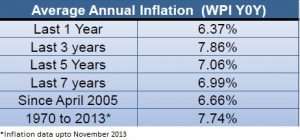A fund to hedge against inflation
Deutsche Mutual (DWS), in a first of its kind, has launched an open-ended debt fund that will predominantly invest in inflation indexed bonds (IIB) issued by the government.

Called the DWS Inflation Indexed Bond fund, the scheme will seek to invest at least 70% of its assets in inflation linked instruments, predominantly issued by the government. Currently only WPI-linked inflation indexed bonds are traded in the market.
The new fund offer is open from January 16 and closes on January 27. Being open-ended, the scheme will be available for investment after the NFO, on an ongoing basis.
The fund
DWS Inflation Indexed Bond fund will currently invest a good chunk in WPI-linked inflation indexed bonds that are being issued since June 2014. These bonds, which have tenure of 10 years, are traded in the market and reissued every month by the government.
While the coupon rate (over and above inflation) was fixed at 1.44% of the issue initially, with subsequent auctions, the most recent (December) rates were at 3.62% and inflation (WPI) as of November was 7.52%. That makes the current yields of these bonds superior to long-term gilts.
The fund can invest up to 30% in other debt instruments including money market instruments. But with a majority of investment planned in inflation indexed bonds, the credit risk is quite low.
Advantages of taking the fund route
As a retail investor, you can invest in Inflation indexed National Savings Securities – Cumulative (IINS –C) which closes on March 31, 2014. This is linked to the consumer Price Inflation (CPI), as against the listed bonds (in which this fund would invest in) which are linked to the WPI.
Still, taking the fund route would provide the following advantages:
Liquidity
The retail bonds (IINS –C) are not tradable and would require you to hold them for a period of 10 years or exit after 3 years with penalty. There is also no interest payout option and you would be required to wait until maturity for the cumulative amount. Taking the fund route would provide you with liquidity. The fund has an exit load for exits made within a year and nil load post that.
Tax efficiency
The retail bonds (IINS-C) would require you to pay tax at your slab rate on your entire returns (both the inflation linked return and coupon rate). Taking the fund route means you only pay capital gain after a year. A holding of more than a year would allow you to enjoy capital gains indexation benefit as well.
No upper limit
The retail bond curtails the maximum money you can invest as a retail investor (Rs 5 lakh). There is no such upper limit with funds.
Expert knowledge
Even assuming you manage to trade in WPI-linked bonds directly, there is always the risk of losing, as prices do fluctuate in the market. Investing in this segment through the fund route ensures you have access to all the latest issues. The fund manager is also better placed to decide which issue to exit when and which ones to go for afresh.
Compounding works well
With inflation indexed bonds, the principal is adjusted for inflation and the coupon payouts are calculated on the adjusted principal. Besides, as a holder in a fund, the bond payouts are added to the NAV, thus providing you with seamless compounding.
What we think
On the face of it, investing in bonds linked to WPI may seem a lesser investment option as they do not capture the real consumer inflation. That said, given the poor tax treatment for the retail bonds currently on offer, the net returns may not really vary on a post-tax return basis for those especially in the 20-30% tax bracket.

While the coupon rate started off with 1.44% in the WPI bonds, the last issued rate was 3.62%. At this rate, you would just need an inflation of 5.2% to earn as much as 10-year gilts (8.83% as of December 31, 2013). However, as the table shows, WPI has averaged at 7.74% a year for several decades now; suggesting that higher returns over gilts are currently possible.
But it is noteworthy that in times of low inflation, the fund cannot be expected to beat other debt categories that may play the duration game favorably. Also, the bond returns may not be the final returns from the fund as expense ratio will pinch the returns a bit.
Still, the idea is a novel one for those simply looking to hedge themselves against inflation for their long-term goals, with the least amount of risk. The fund will be managed by Kumaresh Ramakrishnan and Nitish Gupta. The scheme has dividend payout (monthly, quarterly), dividend reinvestment, growth and bonus options.








VERY USEFUL INFORMATION THAT YOU HAVE PARTED WITH .THANKS.
Would there be any tax benefits by investing in this fund?
Also, what are you views about the newly launched DWS Global Fund (DWS Top Euroland Offshore fund), for those investors who want to invest internationally. Also how would it compare against other Global Funds by other AMC’s.
Gunjan, No special tax benefit. as mentioned, caapital indexation benefit will be available, like all other debt funds, if held for more than a year. Look out for our Europe funds review soon. thanks,
Would there be any tax benefits by investing in this fund?
Also, what are you views about the newly launched DWS Global Fund (DWS Top Euroland Offshore fund), for those investors who want to invest internationally. Also how would it compare against other Global Funds by other AMC’s.
Gunjan, No special tax benefit. as mentioned, caapital indexation benefit will be available, like all other debt funds, if held for more than a year. Look out for our Europe funds review soon. thanks,
VERY USEFUL INFORMATION THAT YOU HAVE PARTED WITH .THANKS.